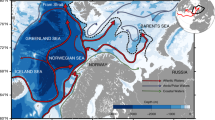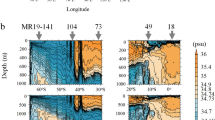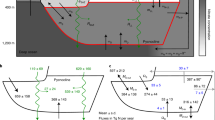Abstract
STUDIES in physical oceanography, both by observation (as summarized by Defant1) and by theory (as summarized by Stommel2), have led to the development of the concept of relatively rapidly flowing currents transporting considerable masses of water at intermediate depths northward or southward to and across the equator in the Atlantic Ocean. Measurement in these current systems of the changes in concentration of strontium-90 distributed by fall-out appears to offer an independent approach to the assessment of these circulations. Conversely, substantial agreement between observed patterns of strontium-90 distribution, and details of those predicted on physical oceanographic grounds, may be taken as evidence supporting the accuracy of the radioisotope analyses. The radiochemical and geochemical aspects of strontium-90 analyses have been discussed elsewhere3–8.
This is a preview of subscription content, access via your institution
Access options
Subscribe to this journal
Receive 51 print issues and online access
$199.00 per year
only $3.90 per issue
Buy this article
- Purchase on Springer Link
- Instant access to full article PDF
Prices may be subject to local taxes which are calculated during checkout
Similar content being viewed by others
References
Defant, A., Physical Oceanography, 1 (Pergamon Press, Oxford, 1961).
Stommel, H., The Gulf Stream (Univ. Cal. Press, Berkeley, Cal., 1958).
Bowen, V. T., and Sugihara, T. T., Nature, 186, 71 (1960).
Bowen, V. T., and Sugihara, T. T., in Radioecology, 135 (Reinhold, New York, 1963).
Bowen, V. T., and Sugihara, T. T., Arctic, 17, 198 (1964).
Bowen, V. T., and Sugihara, T. T., J. Mar. Res., 23, 123 (1965).
Rocco, G. G., and Broecker, W. S., J. Geophys. Res., 68, 4501 (1963).
Miyake, Y., Saruhashi, K., Katsuragi, Y., and Kanazawa, T., Papers Meteorology and Geophysics, Tokyo, 12, 85 (1961); J. Radiat. Res.(Japan), 3, 141 (1962).
Wüst, G., Geologische Rundschau, 47, 187 (1958).
National Radiation Laboratory, Dept. Health, Christchurch, New Zealand, Report No. NRL-F 16, Fall-out in New Zealand. Reprinted in Hardy, jun., E. P., and Rivera, J. (eds.), U.S. Atomic Energy Commission, Health and Safety Laboratory, Report HASL-164, 223 (1965).
Popov, N. I., Evaluation of the Total Quantity of Strontium-90 in the World Ocean (State Committee on the Uses of Atomic Energy U.S.S.R., Moscow, 1965. Translation distributed by the U.S. Atomic Energy Commission, Health and Safety Laboratory, New York, 1966).
Folsom, T. R. (personal communication).
Broecker, W. S., Bonebakker, E., and Rocco, G. G., J. Geophys. Res., 71, 1999 (1966).
Noshkin, V. E., and Sutton, D. C., in Hardy, jun., E. P., and Rivera, J. (eds.), U.S. Atomic Energy Commission, Health and Safety Laboratory Report HASL-171, 389 (1966).
Author information
Authors and Affiliations
Rights and permissions
About this article
Cite this article
BOWEN, V., NOSHKIN, V. & SUGIHARA, T. Transport of Strontium-90 Towards the Equator at Mid-depths in the Atlantic Ocean. Nature 212, 383–384 (1966). https://doi.org/10.1038/212383a0
Issue Date:
DOI: https://doi.org/10.1038/212383a0
This article is cited by
-
Eine Methode zur Anreicherung und Bestimmung sehr geringer Gehalte von Cs 137 in ozeanischem Tiefenwasser
Deutsche Hydrographische Zeitschrift (1974)
Comments
By submitting a comment you agree to abide by our Terms and Community Guidelines. If you find something abusive or that does not comply with our terms or guidelines please flag it as inappropriate.



